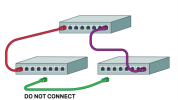Good Morning all,
As always I appreciate all the help I receive from the board.
My UniFi USG router went out on me and find out they don't make them anymore as of 3 years ago and don't support them.
So I thought I would replace it for whatever took its place. The UniFi Cloud Gateway Ultra is what was recommended as a replacement.
After a little challenge, for me, I got the LAN back up but still have problems with the WAN. I connected everything the same way as I
had with the USG. Now it seams I have to log into the Gateway to see my topology and profiles rather than UniFi network application page.
Anyway, I now get a "STP Blocked Network Loop" error notification. I don't have a clue where to start with this. I am Gen X and I spoke floppy disc at one time.
A break down on my set up.
I have my new gateway connected to ISP. I have a switch connected to gateway. I have two desk tops connected to that switch (for ethernet) and another switch
that handles the security cameras and a LR access point.
On my topology page one of my desk tops has a pulsating circle around its icon that I don't know why. Maybe my STP problem but, I don't know.
I am also thinking that these problems are what is causing my WAN problems....
So, for starts, does anyone have a solution for my STP problem?
Thanks all
As always I appreciate all the help I receive from the board.
My UniFi USG router went out on me and find out they don't make them anymore as of 3 years ago and don't support them.
So I thought I would replace it for whatever took its place. The UniFi Cloud Gateway Ultra is what was recommended as a replacement.
After a little challenge, for me, I got the LAN back up but still have problems with the WAN. I connected everything the same way as I
had with the USG. Now it seams I have to log into the Gateway to see my topology and profiles rather than UniFi network application page.
Anyway, I now get a "STP Blocked Network Loop" error notification. I don't have a clue where to start with this. I am Gen X and I spoke floppy disc at one time.
A break down on my set up.
I have my new gateway connected to ISP. I have a switch connected to gateway. I have two desk tops connected to that switch (for ethernet) and another switch
that handles the security cameras and a LR access point.
On my topology page one of my desk tops has a pulsating circle around its icon that I don't know why. Maybe my STP problem but, I don't know.
I am also thinking that these problems are what is causing my WAN problems....
So, for starts, does anyone have a solution for my STP problem?
Thanks all

